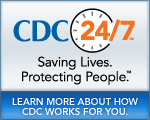MMWR
Morbidity and Mortality Weekly Report
MMWR News Synopsis for October 15, 2009
- Box a€“ Breast Cancer and Disabilities Awareness Month a€“ October 2009
- Prevalence of Duchenne/Becker Muscular Dystrophy Among Males Aged 5-24 Years a€“ Four States, 2007
- Progress Toward Global Elimination of Dracunculiasis, January 2008-June 2009
There is no MMWR telebriefing scheduled for October 15, 2009.
1. Box a€“ Breast Cancer and Disabilities Awareness Month a€“ October 2009
Press Contact: CDC, Division of Media Relations
Phone: (404) 639-3286
No Summary Available.
2. Prevalence of Duchenne/Becker Muscular Dystrophy Among Males Aged 5-24 Years a€“ Four States, 2007
Press Contact: CDC, Division of Media Relations
Phone: (404) 639-3286
These results indicate an overall site-specific prevalence of Duchenne/Becker Muscular dystrophy (DBMD) on January 1, 2007, of 1.3a€“1.8/10,000 males aged 5a€“24 years. Data show that some males (29 percent) who have DBMD experience impaired mobility by the end of their first decade of life and more than 90 percent used wheelchairs by the end of their second decade of life. The analysis of survival among MD STARnet subjects indicated that all males born during 1993a€“2002 (corresponding to ages 5a€“9 years) were surviving at the end of 2007, and nearly 60 percent of those born during 1983a€“1987 (corresponding to ages 20a€“24 years) were surviving. As males with DBMD increasingly survive into adulthood, practitioners who care for adults are challenged to manage patients who have rare disorders, such as DMD, that historically did not survive to adulthood. Programs are needed to address the changing medical, psychosocial, educational, and vocational needs of young men who have DBMD. This report describes the first assessment of population-based DBMD, rare genetic disorders that predominantly affect males and are characterized by progressive skeletal muscle weakness, prevalences in the United States. This study summarizes findings the Muscular Dystrophy Surveillance Tracking and Research Network (MD STARnet), a population-based surveillance system, and is focused on the number of males with DBMD born between 1983 and 2002 (males aged 5 to 24 years), their wheelchair use, and their survival through 2007 in four states: Arizona, Colorado, Iowa, and 12 counties in western New York. Among these states, the overall state-specific prevalences on January 1, 2007 ranged from 1.3/10,000 (1 in 5,556) to 1.8/10,000 (1 in 7,692) males aged 5- 24 years.??
3. Progress Toward Global Elimination of Dracunculiasis, January 2008-June 2009
Press Contact: CDC, Division of Media Relations
Phone: (404) 639-3286
Dracunculiasis, Guinea worm disease, can become the first parasitic disease to be eradicated and the first disease to be eradicated without the use of vaccine or curative drug.?? Annual cases of dracunculiasis (Guinea worm disease) have decreased from 3.5 million in 20 countries to less than 5,000 since the World Health Assembly mandated eradication in 1986. This report updates continued progress towards the eradication of dracunculiasis since January 2008. At the end of 2008 dracunculiasis remained endemic in only six countries (Ethiopia, Ghana, Mali, Niger, Nigeria, and Sudan). As of June 2009, only 1,446 cases were reported from the six countries with endemic disease, and 98 percent of these cases were reported from Sudan and Ghana.?? Nigeria and Niger reported zero cases of dracunculiasis during 2009, so far, and may have already interrupted transmission during 2008.Currently insecurity (e.g., sporadic violence or civil unrest) in areas of Southern Sudan and in Mali poses the greatest threat to success of the global dracunculiasis eradication program.
####
- Historical Document: October 15, 2009
- Content source: Office of Enterprise Communication
- Notice: Linking to a non-federal site does not constitute an endorsement by HHS, CDC or any of its employees of the sponsors or the information and products presented on the site.
View Press Releases in
Get e-mail updates
To receive e-mail updates about this page, enter your
e-mail address:
Contact Us:
- Centers for Disease Control and Prevention
1600 Clifton Rd
Atlanta, GA 30333 - 800-CDC-INFO
(800-232-4636)
TTY: (888) 232-6348 - Contact CDC-INFO


